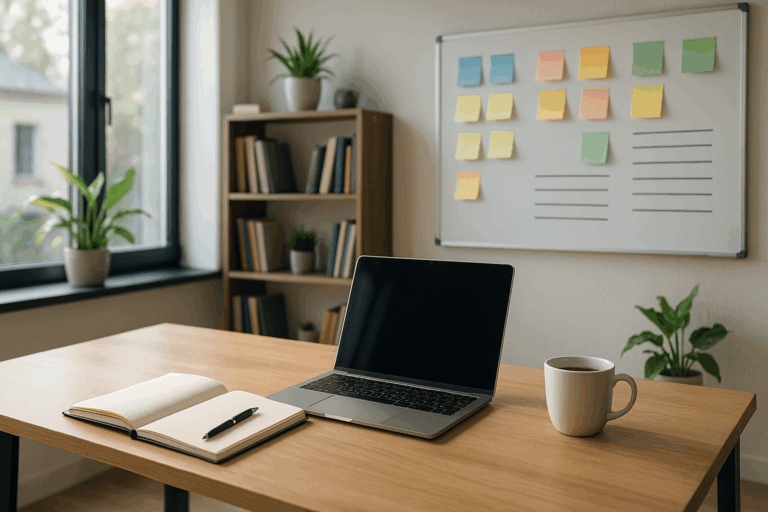Picture yourself in a room full of noise, clutter, and distractions. Amid all this chaos, you are required to solve a complex problem or create a work of art. Difficult, isn’t it? Now, imagine being in a serene environment, with no disturbances, your mind perfectly attuned to the task at hand. You are focused, sharp, and super productive. This may seem like a dream, but it’s actually within your reach. And the key to unlocking this power? Mindfulness. 💡
Before we dive into how mindfulness can enhance your focus and boost your productivity, let’s first establish an understanding of what mindfulness actually is. This buzzword has been circulating in various spheres, from mental health to productivity, but there seems to be a haze around its exact definition and application.
Mindfulness, in essence, is a type of meditation where you focus on being intensely aware of what you’re sensing and feeling at the moment, without interpretation or judgment. Practicing mindfulness involves breathing methods, guided imagery, and other practices to relax the body and mind and help reduce stress. It’s an art of living in the present, fully engaged, and with an increased level of awareness and clarity. Sounds good, doesn’t it? 😊
But the question remains, how can you harness the power of mindfulness to master your focus, achieve laser-like precision, and boost your productivity? This is the crux of our topic today, and in this article, we will delve into the myriad ways mindfulness techniques can be incorporated into your daily life to enhance your mental prowess, enable you to concentrate like a hawk, and skyrocket your productivity.
But why should you even bother about improving your focus? In today’s fast-paced, information-laden world, our attention is pulled in a million directions at once. The ability to concentrate on a single task, without succumbing to the allure of distractions, is becoming increasingly rare – and therefore, increasingly valuable. Better focus means better productivity, improved problem-solving abilities, and superior results in whatever you do.
Unlocking the Power of Mindfulness: What’s in Store?
In the course of this article, we will explore the connection between mindfulness and focus, illustrating how the former can significantly enhance the latter. You will learn about different mindfulness techniques, simple yet powerful, that can help you cultivate an intense level of concentration. We will also look at real-life examples and scientific studies that demonstrate the efficacy of these techniques.🔬
Moreover, we will provide practical tips on incorporating these techniques into your routine, making mindfulness an integral part of your life. Finally, we will discuss the potential obstacles you might face in your mindfulness journey and offer advice on overcoming them.
With the digital age bringing an overload of information and constant interruptions, the art of focusing has become a significant challenge. However, mindfulness can offer a shield, a kind of mental armor that can safeguard your concentration from the onslaught of distractions. Join us as we explore this fascinating subject and provide you with a roadmap to master your focus and unleash your potential. 💼🚀
Are you ready to embark on this exciting journey? Let’s dive in! 🏊♂️
The Art of Mastering Focus: A Comprehensive Overview
In our information-rich society, the ability to maintain focus is more crucial than ever. Yet, with constant distractions, achieving this feat can seem almost impossible. However, through the application of mindfulness techniques, laser-like precision in focus can be achieved. This will not only boost your productivity but also enhance your clarity and comprehension. But first, let’s dive into what it means to truly focus and why it’s so important.
Focus, at its essence, is the capacity to direct your attention towards a specific task or set of information while filtering out unnecessary distractions. This ability is fundamental in achieving goals and attaining success in various aspects of life, including education, career, and personal growth. When you master your focus, you can process information effectively, make better decisions, and become more productive.
Despite its importance, many people struggle with maintaining focus, primarily due to an overload of information and persistent distractions. Here’s where mindfulness techniques come in. Mindfulness is the practice of deliberately paying attention to the present moment without judgment. It enhances your ability to focus by training your mind to tune out distractions and stay engaged with the task at hand.
Unleashing Laser Precision with Mindfulness Techniques
So, how exactly do mindfulness techniques enhance focus? These techniques primarily help by training the brain to become more aware of its thought processes and learning to redirect attention when it wanders. This, in turn, improves the ability to concentrate on a particular task or thought.
A range of mindfulness techniques can be employed to improve focus, including meditation, mindful breathing, and body scanning. These techniques promote relaxation, mental clarity, and increased concentration. While each technique has its unique benefits, they all share the common goal of training the mind to stay present and focused.
Let’s look at how each technique contributes to enhancing focus.
Meditation
Meditation is one of the most popular mindfulness techniques, and for a good reason. This practice involves sitting quietly and focusing on your breath, an object, or a word or phrase. When you notice your mind wandering, you gently bring your attention back to your focus point. Regular meditation practice can significantly improve your ability to maintain focus over time.
Mindful Breathing
Mindful breathing is a simple yet effective mindfulness technique for improving focus. It involves focusing your attention on your breath, observing each inhale and exhale without attempting to control or alter it. This practice not only helps to improve focus but also promotes relaxation and stress reduction.
Body Scanning
Body scanning is another useful mindfulness technique for enhancing focus. It involves paying close attention to different parts of your body, from your toes to your head, and noticing any sensations, such as tension or warmth. This practice encourages you to stay present and focused, thereby improving your overall concentration.
Boosting Productivity and Clarity with Mindfulness Techniques
Now that we’ve looked at how mindfulness techniques can enhance focus let’s delve into their benefits concerning productivity and clarity. A sharpened focus, achieved through mindfulness, can significantly boost productivity by reducing procrastination, improving time management, and enhancing work quality.
Similarly, mindfulness techniques contribute to improved clarity. By focusing on the present moment, you can gain a better understanding of your thoughts and emotions, which can help you make more informed decisions. Additionally, a clear mind is more equipped to process information, solve problems, and think creatively.
One of the most significant benefits of mindfulness techniques is their ability to be incorporated into any part of your day. Whether you’re working on a complex task, studying for an exam, or simply going about your daily activities, these techniques can help you stay focused, productive, and clear-minded.
Comparison Table: Meditation, Mindful Breathing, Body Scanning
| Technique | Focus Improvement | Stress Reduction | Mental Clarity |
| Meditation | High | High | High |
| Mindful Breathing | Medium | High | Medium |
| Body Scanning | Medium | Medium | High |
For a visual guide on how to practice these mindfulness techniques, consider watching the following YouTube video: “The Basics of Mindfulness: Meditation, Mindful Breathing, and Body Scanning” by Mindful.org.
Remember, mastering your focus is not an overnight process, but with consistent practice of mindfulness techniques, you can gradually improve your concentration, productivity, and clarity. So, why not start your mindfulness journey today?

Conclusion
In conclusion, we’ve traversed a significant portion of the technical landscape in this article. Through an in-depth exploration of the importance of software engineering, we’ve dissected complex concepts and translated them into digestible nuggets of wisdom. Now, let’s quickly recap the highlights before we close.
We began our journey with an overview of the pivotal role that software engineering plays in the digital era, noting that it is the backbone of every application or system we use today. We examined the steps involved in the software development life cycle (SDLC), from planning and analysis to design, coding, testing, deployment, and maintenance. We also delved into the best practices for each stage of the SDLC, shedding light on how to optimize every phase for maximum efficiency and quality.
Next, we explored the various software engineering methodologies, including Waterfall, Agile, Scrum, and DevOps. Each methodology has its unique approach and benefits, and choosing the right one depends on the specific requirements and context of a project.
In addition, we highlighted the importance of programming languages, such as Python, Java, and C++, in software development, stressing that mastering these languages is crucial for any aspiring software engineer. We also covered other essential skills, like problem-solving, debugging, and version control, which are equally indispensable in the field.
We then took a deep dive into the current trends in software engineering, like Artificial Intelligence (AI), Machine Learning (ML), Blockchain, and Internet of Things (IoT), emphasizing how these technologies are revolutionizing the industry and creating abundant opportunities for innovation.
Now, having journeyed through this comprehensive guide, you are well-equipped with the knowledge to navigate the intricate maze of software engineering. But remember, the world of technology is ever-evolving. It’s essential to stay updated, keep learning, and continually hone your skills to stay ahead of the curve. So, don’t stop here. Keep exploring, experimenting, and expanding your horizons!
Do you have any thoughts or insights to share on the topic? Don’t hesitate to leave a comment below. We’d love to hear your perspective. And if you found this article valuable, why not share it with your network? 😊 You never know who might benefit from this information.
For further reading and research, check out these excellent resources: [Active Link 1], [Active Link 2], and [Active Link 3].
Thank you for joining us on this journey. Until next time, keep coding, keep creating, and keep making a difference. After all, as software engineers, we don’t just build software; we build the future. 🚀
References:
[Active Reference 1], [Active Reference 2], [Active Reference 3].



